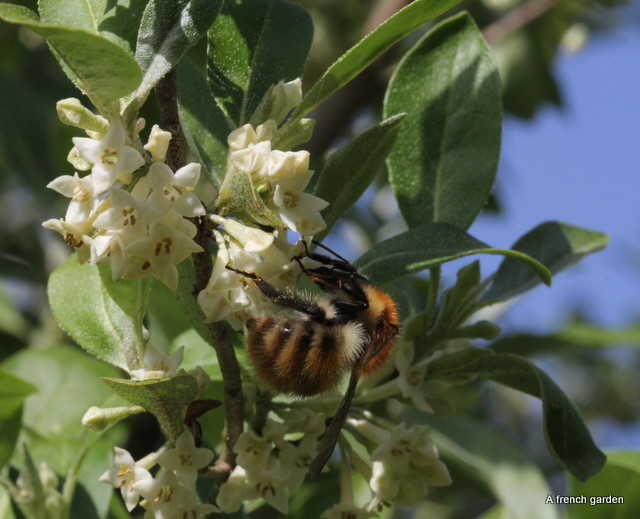
One of the joys of sharing gardens through the blogs is finding the gems that are perfect for your own garden. We bought several of these trees in 2017 and they thrive well in our garden with these pretty flowers in the spring. Eventually, we hope that they will produce fruit.

I have a beautiful dark leaved variety of Honesty that self seeds where it fancies, much to the delight of all the different types of bees. I love it too. A large part of my delight in seeing it flower every year comes from thinking of the friend who sent me the seeds.

The dark honesty is very attractive Amelia. I must try and find some seed here as I haven’t got any honesty in this garden yet. A nice reminder of friends and their kindness. I had never thought of it before, that Eleagnus also produce fruit. Not sure I have ever seen any! That has got me pondering! Thanks for sharing Amelia!
LikeLiked by 1 person
I have also planted one Eleagnus angustifolia which is also called the “Russian olive” because I like the fruits it produces. However, whether the fruits will be produced or even ripen sufficiently here remains to be seen. In the meantime I have a little easy attractive tree with flowers. Amelia
LikeLiked by 1 person
We have a variety of your Eleagnus–commonly called Autumn Olive. They are hardy, to the point of invasive. The fruit is wonderful–makes a tart jelly, especially good with meats. And it is one of the very few wood plants that is nitrogen fixing. Sigh. So why am I pulling it all out? It is a non-native invasive. At first I was happy to leave it be, thinking that it was good wild forage and food for birds. But then the truth emerged–those lovely berries–with their unfortunate fibrous center–might be good for condiments, but it was disastrous for migrating birds. The fibrous parts take so much energy to process, that the poor birds net a zero caloric benefit. The time and energy eating autumn olive actually costs them in their travels. So now we pull or cut them. It’s too bad, the blooms are wildly aromatic–and the bees love them. But I cannot sacrifice the birds for the bees.
LikeLiked by 1 person
Interesting, I had never heard of its effects on birds. I’ll have to check out if the birds eat it here, if we ever get the fruit. Sounds like a good diet food if it tastes good :). Amelia
LikeLiked by 1 person
For humans, one separates out the fibrous interior. It’s not an easy fruit to can–but well worth the extra effort. (our chickens love them, but they have lots of available calories, and they’re not flying south. I’ve decided that I’m doing my bit by removing them–but I could still harvest from nearby properties–and thus minimize the berries that the birds could get. (Aren’t I so generous?) I think the Russian Olives stay green–while the Autumn Olives ripen to a deep, slightly spotted red–in the autumn. The berries have a distinctive sweet, then tart flavor.
LikeLiked by 1 person
Lovely choices – and that dark-leaved honesty sounds like it’s worth searching out. Did you acquire it/sow it hoping for the leaf colour, or did it simply start ‘doing it’s thing’ in your garden?
LikeLiked by 1 person
I admired it some years ago on the post of a fellow blogger who was kind enough to share the seeds with me the following year. I only had the green leaved one before. Amelia
LikeLiked by 1 person
It must be lovely. I’m quite fond of the variegated leaves as well, although normally not into variegation.
LikeLiked by 1 person
What do you think the second bee is?
LikeLiked by 1 person
Truthfully, I have no idea. Do you have an idea? Perhaps a Lasioglossom? It is a female 🙂 Amelia
LikeLike
It could be a lasioglossum but we would need more details to decide, I get very lost with lasioglossum and halictus.
LikeLiked by 1 person
I think you can sometimes hazard a guess because of the time of year and what flower they are on. It would be nice to go on a walk with someone in the summer who could point you in the right direction. I would choose David Goulson because I find bumblebees very confusing. If you dream you might as well shoot high.
LikeLiked by 1 person
Well he does have a house in France!
LikeLiked by 1 person
I remember him mentioning that in one of his books. I wonder if he ever stays there?
LikeLike